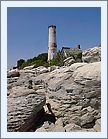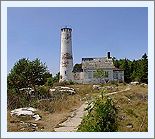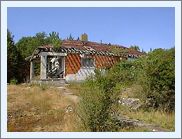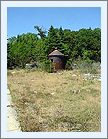|
Historical
Information

After the 1864 completion of the Peninsula Railroad connecting Escanaba
to the iron mines of Negaunee, maritime commerce in and out of Escanaba
exploded as vessels loaded with ore left the growing port headed for
the hungry steel mills along the shores of the eastern lakes.
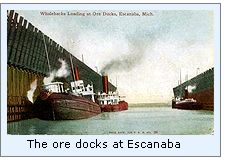 Departing
Escanaba, and heading for the open waters of Lake Michigan, vessels were
forced to thread their way through a chain of islands which spread
themselves across the entrance to Green Bay between the Door and Garden
peninsulas. Traffic bound for the southern ports of Lake Michigan took
the Rock Island Passage which passed between Pottawatomie Light and St. Martin
Island, while traffic setting off to coast the north shore into the
Straits took the more northerly Poverty Island Passage, between Poverty
and Gull Islands. Departing
Escanaba, and heading for the open waters of Lake Michigan, vessels were
forced to thread their way through a chain of islands which spread
themselves across the entrance to Green Bay between the Door and Garden
peninsulas. Traffic bound for the southern ports of Lake Michigan took
the Rock Island Passage which passed between Pottawatomie Light and St. Martin
Island, while traffic setting off to coast the north shore into the
Straits took the more northerly Poverty Island Passage, between Poverty
and Gull Islands.
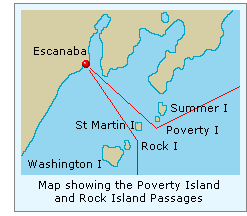 Shoals
surrounding the Gull Islands forced vessels to hold close to the south
shore of Poverty Island, where depths averaged over 70 feet and provided
safe passage for vessels of all sizes. However, with no light to guide
vessels through the passage, vessels unfortunate enough to be ready to
enter Poverty Island passage under the cover of darkness were forced to
wait until daylight before beginning their way through. Shoals
surrounding the Gull Islands forced vessels to hold close to the south
shore of Poverty Island, where depths averaged over 70 feet and provided
safe passage for vessels of all sizes. However, with no light to guide
vessels through the passage, vessels unfortunate enough to be ready to
enter Poverty Island passage under the cover of darkness were forced to
wait until daylight before beginning their way through.
In an attempt to remedy
the situation, in its annual report for 1867 the Lighthouse Board
requested an appropriation of $18,000 for the construction of a light
station on the southern tip of Poverty Island. When no response was
received the following fiscal year, the Board reiterated the request in
its next four annual reports. However, it was not until a number of
memorials from Michigan and New York maritime interests were presented
to Congress early in 1872 that the matter appears to have been given
serious consideration, being referred to the Department of Commerce for
an investigation of feasibility. Congress finally appropriated the
necessary funds on March 3, 1873, and a crew resumed work at Poverty
Island on August 28 of that same year.
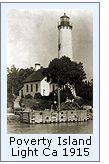 Designed as a virtual
duplicate of the station built at Sturgeon Point three years previous,
construction was progressing well when on October 25, a fire in the
temporary barracks built for the construction crew grew quickly out of
hand, destroying both the barracks and much of the construction
materials stored on-site. With it being so late in the season, and
without the funds to replace the lost supplies, work on the island ended
for the season, and the crew was removed. Designed as a virtual
duplicate of the station built at Sturgeon Point three years previous,
construction was progressing well when on October 25, a fire in the
temporary barracks built for the construction crew grew quickly out of
hand, destroying both the barracks and much of the construction
materials stored on-site. With it being so late in the season, and
without the funds to replace the lost supplies, work on the island ended
for the season, and the crew was removed.
Work resumed in May of
1874 with the delivery of a small working party, and progressed though
the summer until all available funds were depleted. With the keeper's
dwelling completed and the tower completed to a height of 31 feet, a
temporary light was installed on the roof of the dwelling on August 1,
and the crew removed once again until the funds required to complete the
project became available.
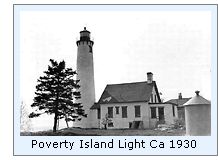 Congress appropriated
the additional $3,000 on March 3, 1875 and work on the Poverty Island
station resumed soon thereafter. By the beginning of August, work on the
station was virtually complete, with both the keeper's dwelling, tower
and connecting walkway constructed of red brick, with the tower standing
seventy feet from the top of the dressed-stone foundation to the
ventilator ball atop the decagonal cast iron lantern. The district
Lampist installed the flashing red Fourth Order Fresnel lens atop its
cast iron pedestal at a point 65 feet above the base of the tower. The
tower's location some thirteen feet above the level of the lake,
provided the lens with a focal plane of seventy-eight feet, and a
visibility range of sixteen miles at sea in all directions. The new
light was exhibited from the tower for the first time on the evening of
August 10, 1875, and with the removal of the temporary light on the
keepers dwelling, the work party departed the island after three years
on the island. Congress appropriated
the additional $3,000 on March 3, 1875 and work on the Poverty Island
station resumed soon thereafter. By the beginning of August, work on the
station was virtually complete, with both the keeper's dwelling, tower
and connecting walkway constructed of red brick, with the tower standing
seventy feet from the top of the dressed-stone foundation to the
ventilator ball atop the decagonal cast iron lantern. The district
Lampist installed the flashing red Fourth Order Fresnel lens atop its
cast iron pedestal at a point 65 feet above the base of the tower. The
tower's location some thirteen feet above the level of the lake,
provided the lens with a focal plane of seventy-eight feet, and a
visibility range of sixteen miles at sea in all directions. The new
light was exhibited from the tower for the first time on the evening of
August 10, 1875, and with the removal of the temporary light on the
keepers dwelling, the work party departed the island after three years
on the island.
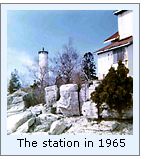 After ten years of
relative peace and quiet on the island, the keeper's knew their lives
were to be inexorably changed when the Lighthouse tender WARRINGTON
delivered a work party and supplies for the construction of a fog-signal
station on the island during the summer of 1885. Work on the structure
and its duplicate boilers and 10-inch steam whistles was finished at the
end of September, with the fog signal officially placed in operation on
October 1. After ten years of
relative peace and quiet on the island, the keeper's knew their lives
were to be inexorably changed when the Lighthouse tender WARRINGTON
delivered a work party and supplies for the construction of a fog-signal
station on the island during the summer of 1885. Work on the structure
and its duplicate boilers and 10-inch steam whistles was finished at the
end of September, with the fog signal officially placed in operation on
October 1.
September 1894 saw the
construction of a circular iron oil house at the station, and an
L-shaped boat landing. That winter was also memorable, as the station's
keepers toiled to load 6 tons of coal and 48 cords of wood into the fog
signal's hungry boilers in order to keep the whistles wailing for a
total of 489 hours, the most hours of operation in any single year in
the station's history.
The light in the
station's lantern was automated in 1957, and with the installation of a
300 mm acrylic optic atop a skeletal steel tower in 1976, the cast iron
lantern was removed from the tower, and the tower sealed-off. The
lantern was unceremoniously lowered to the ground, and left to lay with
the station's abandonment. During the 1980's, representatives of Delta
County Historical Society became aware of the old lantern's existence,
and obtained permission from the Coast Guard to transport it back to
Escanaba for installation atop the newly reconstructed Sand Point Light
station tower, where it sits to this day.

Keepers of this
Light

Click Here to see a complete listing of
all Poverty Island Light keepers compiled by Phyllis L. Tag of Great
Lakes Lighthouse Research.

Finding this
Light

We
understand that Shoreline
Resort at Gills Rock is now offering charter trips around St.
Martin and Poverty Islands aboard their converted Navy P.B.R. Contact
then directly for additional information on these charters.

Reference Sources

Great Lakes Light Lists for 1876, 1924 & 1953.
Annual reports of the Lighthouse Board, 1864 through 1909.
Great Lakes Coast Pilot, 30th Edition, NOAA.
Research preparing for creation of Sand Point page, September
2000.
2001 Photographs courtesy of Larry Bell.
Keeper listings for this light appear courtesy of Great
Lakes Lighthouse Research
|
